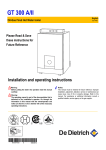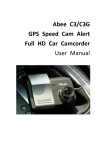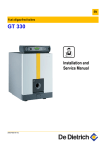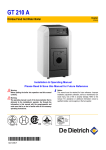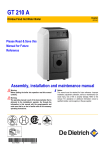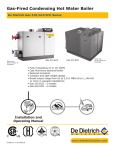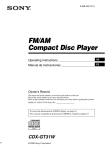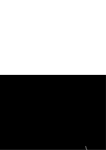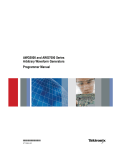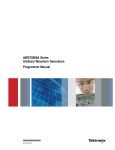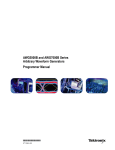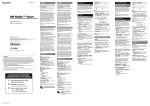Download CSA American GT-305-PE Operating instructions
Transcript
GT 330 A English Oil-Gas Fired Hot Water boiler 11/20/09 Installation and operating instructions Warning: Before putting the boiler into operation read this manual carefully. Warning: The operating manual is part of the documentation that is delivered to the installation’s operator. Go through the information in this manual with the owner/operator and make sure that he or she is familiar with all the necessary operating instructions. 85534150 Notice: This manual must be retained for future reference. Improper installation, adjustment, alteration, service or maintenance can cause injury, loss o f life or property damage. Refer to this manual. For assistance or additional information consult a qualified installer, service agency or the gas supplier. 11-20-09 Guideline of Notices Warning: indicates presence of hazards that can cause, if not avoided, severe personal injury, death or substantial property damage. ! Caution: indicates presence of hazards t hat will or ca n cause, if not avoided, minor personal injury or property damage. Notice: Application comment for optimum use of equipment and adjustment as well as useful information. Safety Considerations Please observe the following safety instructions. Read this manual carefully. Correct in stallation and adjustment of the burner and the control panel is a precondition for safe, efficient operation of the gas boiler. Read this manual and the specifications on the safety label carefully before attempting to put the burner into operation. not store or use gasoline or other flammable liquids in Do the vicinity of this or any other appliance. Installation and service must be peformed by a qualified installer, service agency or the gas supplier. ZReference to an other instruction book. WHAT TO DO IF YOU SMELL GAS: - Do not try to light any appliance. - Do not touch any electric switch, do not use any phone in your building. - Immediately call your gas supplier from a neighbor’s phone. Follow the gas supplier’s instructions. - If you cannot reach your gas supplier, call the Fire Department. Observe the following symbols DANGER due to explosion of gas. - Work only on gas components when you have a license to do so. - Note t hat the a ssembly of gas and vent connections, the initial start-up, the electrical connections, the mainte nance and service can only be perfor med by a licensed se rvice contra ctor or technician. ! ! DANGER due to electricity. Warning: Improper installation, adjustment, and/or operation could - Prior to doing any work on the heating system, disconnect all electrical power to the boiler at the emergency switch. - It is NOT sufficient to shut off only the boiler control! CAUTION! SYSTEM DAMAGE due to improper installation. - Observe l ocal and state codes as well as common i ndustry practices during the install ation and operation of the heating appliance. CAUTION! SYSTEM DAMAGE due to inadequate cleaning and maintenance. - A boiler cleaning and maintenance should be performed annually. Verify complete system operation at the same time. - Correct the prob lem immediately to prevent damage to the system! ! ! cause carbon monoxide poisoning resulting in injury or death. This product must be installed and serviced by a professional service technician who is experienced and qualified in hot water boiler installation and gas combustion. Caution: Strict compliance with these instructions is a precondition for the correct operation of the boiler. IMPORTANT Service on this boiler should be undertaken only by trained and skilled personnel. Keep bo iler area cle ar and free from combustible materials, gasoline and other flammable vapors and liquids. Do not place any obstruction in the boiler room that will hinder the flow of combustion and ventilating air. Read these instructions carefully before proceeding with the installation of boiler. Post instructions near boiler for reference by owner and serviceman. Maintain instructions in legible condition. "All installations of this appliance must be be in accordance to all national and local codes and authorities having jurisdiction" [Canadian Installation] CSA B139 for Oil & CSA B149 for Gas [USA Installations] NFPA 54/ANSI Z223.1 for Gas & NFPA 31 for Oil This boiler must be connected to a venting that will safely and effectively discharge all flue gases to the outside in an effective manner. Never burner garbage or paper in the unit, and never leave combustible materials around it. Do not use gasoline, crankcase draining, or any other oil containing gasoline 2 85534150 11-20-09 Contents Contents . . . . . . . . . . . . . . . . . . . . . . . . . . . . . . . . . . . . . . . . . . . . . . . . . . . . . . . . . . . . . . . . . . . . . . . . . . . . . . . . . . . .3 Regulations and guidelines . . . . . . . . . . . . . . . . . . . . . . . . . . . . . . . . . . . . . . . . . . . . . . . . . . . . . . . . . . . . . . . . . . . .4 Installation codes. . . . . . . . . . . . . . . . . . . . . . . . . . . . . . . . . . . . . . . . . . . . . . . . . . . . . . . . . . . . . . . . . . . . . . . . . . . . .4 General . . . . . . . . . . . . . . . . . . . . . . . . . . . . . . . . . . . . . . . . . . . . . . . . . . . . . . . . . . . . . . . . . . . . . . . . . . . . . . . . . . . . .4 1 2 3 4 Uncrating . . . . . . . . . . . . . . . . . . . . . . . . . . . . . . . . . . . . . . . . . . . . . . . . . . . . . . . . . . . . . . . . . . . . . . . . . . . . . . . . . . . . . . . . . . . . . . . .4 Packing. . . . . . . . . . . . . . . . . . . . . . . . . . . . . . . . . . . . . . . . . . . . . . . . . . . . . . . . . . . . . . . . . . . . . . . . . . . . . . . . . . . . . . . . . . . . . . . . . .4 Technical specifications of boilers . . . . . . . . . . . . . . . . . . . . . . . . . . . . . . . . . . . . . . . . . . . . . . . . . . . . . . . . . . . . . . . . . . . . . . . . . . . . .5 Main Dimensions . . . . . . . . . . . . . . . . . . . . . . . . . . . . . . . . . . . . . . . . . . . . . . . . . . . . . . . . . . . . . . . . . . . . . . . . . . . . . . . . . . . . . . . . . .6 Boiler Installation. . . . . . . . . . . . . . . . . . . . . . . . . . . . . . . . . . . . . . . . . . . . . . . . . . . . . . . . . . . . . . . . . . . . . . . . . . . . .7 1 Installation . . . . . . . . . . . . . . . . . . . . . . . . . . . . . . . . . . . . . . . . . . . . . . . . . . . . . . . . . . . . . . . . . . . . . . . . . . . . . . . . . . . . . . . . . . . . . . .7 2 Ventilation. . . . . . . . . . . . . . . . . . . . . . . . . . . . . . . . . . . . . . . . . . . . . . . . . . . . . . . . . . . . . . . . . . . . . . . . . . . . . . . . . . . . . . . . . . . . . . . .7 3 Assembly . . . . . . . . . . . . . . . . . . . . . . . . . . . . . . . . . . . . . . . . . . . . . . . . . . . . . . . . . . . . . . . . . . . . . . . . . . . . . . . . . . . . . . . . . . . . . . . .7 Piping . . . . . . . . . . . . . . . . . . . . . . . . . . . . . . . . . . . . . . . . . . . . . . . . . . . . . . . . . . . . . . . . . . . . . . . . . . . . . . . . . . . . . .8 1 2 3 4 Dimensional information required. . . . . . . . . . . . . . . . . . . . . . . . . . . . . . . . . . . . . . . . . . . . . . . . . . . . . . . . . . . . . . . . . . . . . . . . . . . . . .8 Recommendations . . . . . . . . . . . . . . . . . . . . . . . . . . . . . . . . . . . . . . . . . . . . . . . . . . . . . . . . . . . . . . . . . . . . . . . . . . . . . . . . . . . . . . . . .8 Filling . . . . . . . . . . . . . . . . . . . . . . . . . . . . . . . . . . . . . . . . . . . . . . . . . . . . . . . . . . . . . . . . . . . . . . . . . . . . . . . . . . . . . . . . . . . . . . . . . . .8 Ancillaries . . . . . . . . . . . . . . . . . . . . . . . . . . . . . . . . . . . . . . . . . . . . . . . . . . . . . . . . . . . . . . . . . . . . . . . . . . . . . . . . . . . . . . . . . . . . . . . .9 Combustion and ventilation . . . . . . . . . . . . . . . . . . . . . . . . . . . . . . . . . . . . . . . . . . . . . . . . . . . . . . . . . . . . . . . . . . .10 1 Clearances . . . . . . . . . . . . . . . . . . . . . . . . . . . . . . . . . . . . . . . . . . . . . . . . . . . . . . . . . . . . . . . . . . . . . . . . . . . . . . . . . . . . . . . . . . . . . .10 2 Replacement procedures . . . . . . . . . . . . . . . . . . . . . . . . . . . . . . . . . . . . . . . . . . . . . . . . . . . . . . . . . . . . . . . . . . . . . . . . . . . . . . . . . . .11 3 Dimensional information required for connection of the boiler . . . . . . . . . . . . . . . . . . . . . . . . . . . . . . . . . . . . . . . . . . . . . . . . . . . . . . .12 Oil or gas connections . . . . . . . . . . . . . . . . . . . . . . . . . . . . . . . . . . . . . . . . . . . . . . . . . . . . . . . . . . . . . . . . . . . . . . .12 1 Specific technical information supplied with the burner . . . . . . . . . . . . . . . . . . . . . . . . . . . . . . . . . . . . . . . . . . . . . . . . . . . . . . . . . . . .12 Electrical . . . . . . . . . . . . . . . . . . . . . . . . . . . . . . . . . . . . . . . . . . . . . . . . . . . . . . . . . . . . . . . . . . . . . . . . . . . . . . . . . . .13 1 Wiring . . . . . . . . . . . . . . . . . . . . . . . . . . . . . . . . . . . . . . . . . . . . . . . . . . . . . . . . . . . . . . . . . . . . . . . . . . . . . . . . . . . . . . . . . . . . . . . . . .13 2 Wiring procedure . . . . . . . . . . . . . . . . . . . . . . . . . . . . . . . . . . . . . . . . . . . . . . . . . . . . . . . . . . . . . . . . . . . . . . . . . . . . . . . . . . . . . . . . .13 3 Wiring boiler panel . . . . . . . . . . . . . . . . . . . . . . . . . . . . . . . . . . . . . . . . . . . . . . . . . . . . . . . . . . . . . . . . . . . . . . . . . . . . . . . . . . . . . . . .14 Start up procedures. . . . . . . . . . . . . . . . . . . . . . . . . . . . . . . . . . . . . . . . . . . . . . . . . . . . . . . . . . . . . . . . . . . . . . . . . .15 1 Start up procedures . . . . . . . . . . . . . . . . . . . . . . . . . . . . . . . . . . . . . . . . . . . . . . . . . . . . . . . . . . . . . . . . . . . . . . . . . . . . . . . . . . . . . . .16 2 Shut-down procedures . . . . . . . . . . . . . . . . . . . . . . . . . . . . . . . . . . . . . . . . . . . . . . . . . . . . . . . . . . . . . . . . . . . . . . . . . . . . . . . . . . . . .16 Maintenance . . . . . . . . . . . . . . . . . . . . . . . . . . . . . . . . . . . . . . . . . . . . . . . . . . . . . . . . . . . . . . . . . . . . . . . . . . . . . . . .17 1 Boiler . . . . . . . . . . . . . . . . . . . . . . . . . . . . . . . . . . . . . . . . . . . . . . . . . . . . . . . . . . . . . . . . . . . . . . . . . . . . . . . . . . . . . . . . . . . . . . . . . .17 Service and maintenance schedule . . . . . . . . . . . . . . . . . . . . . . . . . . . . . . . . . . . . . . . . . . . . . . . . . . . . . . . . . . . . .19 Spare parts - GT 300 A/II . . . . . . . . . . . . . . . . . . . . . . . . . . . . . . . . . . . . . . . . . . . . . . . . . . . . . . . . . . . . . . . . . . . . . .20 85534150 11-20-09 3 Regulations and guidelines The installation and operating instructions shown here are given as a guide for installation and operation and are not meant to replace any State or Local Codes that may appl y to the individual installation. Good engineering practice should be used. Any deviation from laws or regulations or industry Code or these instructions will void the boiler warranty and any other respon sability or liability of t he De Dietrich Thermiques S.A. Only a qualified and licenced heating professional is to carry out the removal, installation, startup and maintenance of this boiler. The boiler must be installed according to all national and local codes having jurisdiction. The operation of the boiler must be verified and all safety controls checked. Any defect or abnormal operations must be corrected immediately. The entire system requires annual service and cleaning at least once a year. Installation codes • THE BOILER SHALL BE A SSEMBLED AND INSTALLE D BY A QUALIFIED PROFESSIONAL ONLY. STRICT COMPLIANCE WITH THESE INSTALLATION AND OPER ATING INSTRUCTIO NS IS A PRECONDITION FOR THE CORRECT AND GUARANTEE OF THE BOILER. • TH E INSTALLATION MUST CON FORM TO TH E REQUIREMENTS OF THE AUTHORITY HAVING JURISTRICTION OR, IN THE ABSENCE OF SUCH REQUIREMENTS, TO THE CAN/ CGA B-149 FUEL GAS INSTALLATION CODES AND CSA B-139 OIL INSTALLATION CODES. • WHERE REQ UIRED BY THE AUTHORITY HAVING JURISTRICTION, THE INSTALLATION MUST CONFORM TO THE STANDARD FOR CONTROLS AND SAFETY DEVICES FOR AUTOMATICALLY FIRED BOILERS ANSI/ASME CSD-1. • THE INSTALLATIO N OF THE RELIEF VALVE SHALL BE CONSISTENT WITH ANSI/ASME B OILER PRESSURE VES SEL CODE, SECTION IV CSA B51. • THE BOILER MUST NOT BE INSTALLED ON CARPETING. • IF AN EXTE RNAL ELECTRICAL SOURCE IS UTILIZED, THE BOILER WHEN INSTALLED, MUST BE ELECTRICALLY BONDED TO GROUND IN ACCORDANCE WITH THE REQUIREMENTS OF THE AUTHORITY HAVING JU RISTRICTION OR, IN T HE ABSENCE O F SUCH REQUIREMENTS , WI TH THE CANADIAN ELECTRICAL CODE PART 1, CSA C22.1, ELECTRICAL CODE. ALL WIRES PRIOR TO DISCONNECTION WHEN LABEL SERVICING CONTROLS. WIRING CAN CAUSE IMPROPER OPERATION AFTER SERVICINGS. “VERIFY PROPER OPERATION AFTER SERVICE”. General The GT330 A are series of oil or gas fired, cast iron, automatic boilers. 1 Uncrating Upon arrival, check shipment to ensure all parts have been shipped. Inspect all items for delivery damage. Report all damage and shortages to the delivery carrier. Report any damage and shortages to the Distributor. 2 Packing See the separate assembly instruction book. For the optional equipment you may use with this boiler, see the current price list. 4 85534150 11-20-09 GT 300 A/II Technical Specification Table GT 330A Series - Cast Iron Sectional Boiler Technical Specification Data Table Model Item Unit GT 334A GT 335A Firing Sequence [CSA] - Gas Input [CSA] - # 2 Fuel Oil Input [CSA] - Output [Gas-Oil] GT 336A GT 337A GT 338A GT 339A Consult Burner Technical Data MBH 404 598 808 1,024 1,226 1,442 kW 118 175 237 300 359 423 US GPH 2.80 4.15 5.60 7.10 8.50 10.00 MBH 344 510 688 872 1,044 1,229 kW 100.8 149.4 201.6 255.7 306.1 360.1 NET I=B=R Water Rating MBH 299 443 598 759 908 1,068 Cast Iron Sections # 4 5 6 7 8 9 Flue-way baffles # 6 10 10 10 12 12 US Gal 25.36 30.65 35.93 41.22 46.50 51.78 Liter 96 116 136 156 176 196 18° F Ft. H2O [mbar] 0.483 [14.451] 1.026 [30.674] 2.099 [62.730] 3.055 [91.326] 4.380 [130.923] 6.332 [189.269] 27° F Ft. H2O [mbar] 0.215 [6.421] 0.457 [13.673] 0.933 [27.884] 1.358 [40.585] 1.945 [58.144] 2.818 [84.240] 36° F Ft. H2O [mbar] 0.121 [3.615] 0.256 [7.666] 0.525 [15.682] 0.764 [22.831] 1.094 [32.709] 1.583 [47.317] Water Capacity Water Resistance [∆T = °F] Diameter [equivalent] Combustion Chamber Dimensions Depth Volume Combustion chamber and flue way volume Volume ASME MAWP [Water] Inch 14.84 mm 377 Inch 22.48 28.78 35.08 41.38 47.68 53.98 mm 571 731 891 1,051 1,211 1,371 3 3.39 4.31 5.23 6.14 7.06 7.98 m3 0.096 0.122 0.148 0.174 0.2 0.226 Ft3 5.76 7.27 8.79 10.31 11.83 13.35 0.163 0.206 0.249 0.292 0.335 0.378 957 1,146 1,348 Ft m 3 90 PSI MBH Electrical Connection V/P/H 120/1/60 < 10A Max. Water Temp. Safety Limit [MR] °F Fixed non adjustable 248 S3NA Panel Min. Safety Relief Capacity Water Operating Temperature Range Chamber Resistance 378 560 755 °C Fixed non adjustable 120 °F Adjustable 104 - 212 [factory preset stop at 185] Optional Hi-Temperature kit available °C Adjustable 40 - 100 [factory preset stop at 85] Optional Hi-Temperature kit available Inch w.c. 0.14 0.34 0.67 0.95 1.29 1.45 mbar 0.30 0.60 1.10 1.60 2.20 2.50 Gas-Vent Category # Boiler Vent Connection Inch 7 7 7 8 8 8 lb 1,349 1,623 1,865 2,163 2,432 2,712 kg 612 736 846 981 1103 1230 Weight [Dry] I-II-III-IV & Sidewall Note: • • • • • • • • • CSA - MBH Output based on Thermal Efficiency Test According to ANSI Z21.13a/CSA 4.9a-2005 All Models Certified for 0 - 4,500 feet ASL installation altitude, consult factory for higher altitudes [NET] MBH Output Factor 1.15, Allowance for Piping and Pickup Losses Chamber Resistance Based on Neutral Chimney-Vent Pressure Conversion Btu/Hr to kW = 3,412 Btu/Hr per kW All Models are Design Certified & Eligible to Bear Approval Marking as Shown. All Models Certified to Fire; # 2 oil, Natural & Propane Gases. Consult factory for Available Burners. All Models Comply and Certified in Accordance to the latest Canadian & US standards Due to ongoing and continuous product improvements, DDR Americas Inc. reserves all rights to amend and delete information provided on this product specification table. 4 Main Dimensions GT 330 A A A C B D A Water flow tapping 2 1/2" NPSC C Drain 1 1/2" FPT B Water return 2 1/2" NPSC D Rp 2 1/2 diameter sludge removal hole Type of boiler GT 334 A GT 335 A GT 336 A GT 337 A GT 338 A GT 339 A L 385/8" 4459/64" 517/32 5733/64" 6313/16" 707/64" P 199/32 2519/32" 317/8 383/16" 4431/64" 5025/32" ØR 7" 7" 7" 8" 8" 8" G50_0001 X Dimension "X" Max. Burner Length (inches) Boiler Model GT334 A GT335 A Riello GT338 A Power Flame 19 221/4 26 15/32 GT339 A 23 251/8 Notes: - Dimension are for gas burner only - Oil and combination oil/gas, refer to b specifications 6 Fuel Master Gordon Piatt 191/4 26 10 GT336 A GT337 A Weishaupt urner manufacturer Boiler Installation 1 Installation The GT 300 A/II boiler has a bas e frame, although a housekeeping pad is re commended to keep steel par ts out of casual water. Its furnace is closed, so it is not necessary to place it on a fireproof floor, but the floor must be able to bear the weight. 4"1 /8 8553N138 46" 59/ 64 40" 20" L 31" 32 11/ 20" X Boiler type L GT 304 A/II 33" GT 305 A/II 395/16" GT 306 A/II 459/16" GT 307 A/II 517/8" GT 308 A/II 583/16" GT 309 A/II 641/2" Dimension 'X', consult burner info. additional 24 inches for servicing Caution : note addtional space required when the burner door is open. Multiple installation of several boilers side by side, these dimensions need to be modified. Illustration above showing minimum distances to combustible materials and servicing. Boiler must not be installed on combustible material or on carpet. 2 Combustion Air Supply Boilers operating in atmospheres t hat contain fluorides or chlorides such as beauty shops and automotive repair garage s whe re air conditioning services are performed or industrial applications that may have corrosive elements in the air must have a clean source of combustion and ventilation air. Bo iler damage by contaminants will void the warranty and any other responsibility or liability of De Dietrich Thermique/FES Ltd. 85534150 Ensure boiler room is adequately ventilated and Warning: clear and free from combustible materials, gasoline and other flammable vapours and liquids. Combustion air supply must be provided according to national and local codes: CSA B149.1 -.2 & CSA B139 ANSI Z223.1 & NFPA 31 11-20-09 7 Venting 5. . Boiler Venting & Chimney General Caution & Warning: It is advised and recommended that the heating contractor-professional apply vent materials that are approved and agency listed. Installation of any venting must follow all local codes in conjunction with vent manufacturer instructions and appliance manufacturer instructions. All De Dietrich GT series oil-gas fired cast iron boilers are high performance boilers that could operate under all 4 vent categories as established by ANSI Z21.13/CSA 4.9 Standard. To assist with application where the vent category is unknown a graph below has been provided to assist you in determining the vent category and what venting materials would be acceptable. Although the gas vent categories were developed specifically for gas fired appliances, using this information is helpful for oil fired boilers. It is very important the venting be selected according to the conditions that the boiler will operate under, minimum and maximum firing conditions of the boiler must be respected. The venting installed must comply and be certified to all applicable codes and standards for each jurisdiction. Gas-Vent Category [4] Definitions: Cat. I A Boiler, which operates with a non-positive vent (breech) pressure and flue gas temperatures which avoids excessive condensation production in the chamber and venting. Cat. III A Boiler, which operates with a positive vent (breech) pressure and flue gas temperatures which avoids excessive condensation production in the chamber and venting. Cat. II A Boiler, which operates with a non-positive vent (breech) pressure and flue gas temperatures produce condensation production in the chamber and venting. Cat. IV A Boiler, which operates with a positive vent (breech) pressure and flue gas temperatures produces condensation production in the chamber and venting. Chart A Chart created by Craig Holdforth Gas-Fired Appliance Vent Categorization [According to ANSI Z21.13/CSA 4.9 Gas Boiler Standard] Carbon Dioxide [CO2] Content % 7 8 9 10 11 12 11 10 9 8 500 456 6 260 Category III Typical Vent Types [BH, AL294C®, 304-316L SS] Category I Typical Vent Types [A,B,C & L] 412 Chimney-Vent Flue Gas Temperature °F (Net, Minus Room Temperature) 7 236 211 368 187 324 162 280 138 236 113 192 89 148 104 Category II Typical Vent Types [BH, AL294C®, 304-316L SS] Category IV Typical Vent Types [BH, AL294C®, 304-316L SS] 60 Chimney-Vent Flue Gas Temperature °C (Net, Minus Room Temperature) 6 64 40 15 Negative Chimney-Vent Pressure [Inches w.c.] Positive 9 85534150 11-20-09 5.1 Boiler Venting – Category I & II Typical Layouts and Requirements. Caution & Warning: Improperly sealed venting system could result in carbon monoxide [CO] poisoning; ensure adequate support and fastening of the system. Ensure venting can safely exhaust all flue gases outside in an effective manner. These systems must operate under a negative vent pressure condition that is stable. Warning & Cautions for Co-Venting: Co-venting with other appliances shall conform latest ANSI Z223.1 & CAN/CGA 149 installation codes, any improper operation shall be corrected, the common venting shall be sized according to the appropriate tables in Part II of the above mentioned codes. Category I Vent Systems Requirements: 1. Flue gas temperatures above the green line shown in chart A. 2. Approved type of venting for category I appliances. 3. A barometric draft control maybe employed as required, but is not necessary for correct boiler operation. Consult a chimney-vent specialist for correct application and usage. 4. Breeching and chimney vent sized in accordance to local and national codes or by good engineering methods. 5. Vent safety device equipped on the venting or as equipped on burner. 6. Condensate TEE fitting supplied on the boiler breeching as close as possible and be orientated to avoid accumulation of flue gas condensation in the boiler or venting is also used to determine flue gas emissions. Category II Vent Systems Requirements: 1. Flue gas temperatures below the green line shown in chart A. 2. Approved type of venting for category II appliances. 3. A barometric draft control maybe employed as required, but is not necessary for correct boiler operation. Consult a chimney-vent specialist for correct application and usage. 4. Breeching and chimney vent sized in accordance to local and national codes or by good engineering methods. 5. Vent safety device equipped on the venting or as equipped on burner. 6. Condensate TEE fitting supplied on the boiler breeching as close as possible and be orientated to avoid accumulation of flue gas condensation in the boiler or venting is also used to determine flue gas emissions. Lined Masonry Chimney Caution-Warning: Flue gas condensation is very aggressive and corrosive which could lead to failure of the venting system or drains, consult local and national codes regarding flue gas condensation disposal. The P-trap assembly must be properly filled with water to avoid escape of flue gas emissions. The flue gas condensation may require neutralization prior to entering the drain. 10 85534150 11-20-09 5.2 Boiler Venting – Category III & IV Vent Systems Typical Layouts and Requirements. Caution & Warning: Improperly sealed venting system could result in carbon monoxide [CO] poisoning; ensure adequate support and fastening of the system. Ensure venting can safely exhaust all flue gases outside in an effective manner. These systems must operate under a positive vent pressure condition that is stable. Warning & Cautions for Co-Venting: Co-venting with other appliances shall conform latest ANSI Z223.1 & CAN/CGA 149 installation codes, any improper operation shall be corrected, the common venting shall be sized according to the appropriate tables in Part II of the above mentioned codes. Category III Vent Systems Requirements: 1. Flue gas temperatures above the green line shown in chart A. 2. Approved type of venting for category III appliances 3. Breeching and chimney diameter sized in accordance to national & local codes or by good engineering methods. 4. Vent safety device equipped on burner [MR] 5. Condensate TEE fitting supplied on the boiler breeching as close as possible and be orientated to avoid accumulation of flue gas condensation in the boiler or venting. Category IV Vent Systems Requirements: 1. Flue gas temperatures below the green line shown in chart A. 2. Approved type of venting for category IV appliances 3. Breeching and chimney diameter sized in accordance to national & local codes or by good engineering methods. 4. Vent safety device equipped on burner [MR] 5. Condensate TEE fitting supplied on the boiler breeching as close as possible and be orientated to avoid accumulation of flue gas condensation in the boiler or venting. Caution-Warning: Flue gas condensation is very aggressive and corrosive which could lead to failure of the venting system or drains, consult local and national codes regarding flue gas condensation disposal. The P-trap assembly must be properly filled with water to avoid escape of flue gas emissions. The flue gas condensation may require neutralization prior to entering the drain. 11 85534150 11-20-09 5.3 Boiler Venting – Side-Wall or Direct Vent Systems Typical Layouts and Requirements. Caution & Warning: Improperly sealed venting system could result in carbon monoxide [CO] poisoning; ensure adequate support and fastening of the system. Ensure venting can safely exhaust all flue gases outside in an effective manner. These systems must operate under a positive vent pressure condition that is stable. Do not Co-Vent with any other appliance, the venting system was designed for single appliance venting only. Side-wall & Direct Vent Systems: These systems do not fall under any of the gas vent categories, these systems are pre-engineered. These applications of this venting system must be followed exactly, for safe, efficient and trouble free operation. System Requirements: 1. Venting sized accordance to direct vent table 2. Type “BH” [AL294C®] vent material 3. Condensate TEE fitting supplied on the boiler breeching as close as possible and be orientated to avoid accumulation of flue gas condensation in the boiler or venting is also used for determining flue gas emissions. 4. Vent termination TEE 5. Vent safety device equipped on burner [MR] Vent Termination Locations & Warning – See Section 5.5 Caution-Warning: Flue gas condensation is very aggressive and corrosive which could lead to failure of the venting system or drains, consult local and national codes regarding flue gas condensation disposal. The P-trap assembly must be properly filled with water to avoid escape of flue gas emissions. The flue gas condensation may require neutralization prior to entering the drain. 12 85534150 11-20-09 5.4 Boiler Venting – Side-wall or Direct Vent Systems Sizing Tables & Vent Safety Device • Vent termination must be a TEE type, follow warning regarding termination locations. Do not include the termination TEE length in the vent length calculation. • Venting shall be sloped, so any condensation developed will drain through the condensate TEE fitting Minimum vent length [equivalent] 5 ft. [1.5m] • Maximum number of 90° elbows = 2 or 3 45° elbows, each 90° elbow is equivalent to 10 ft. or straight pipe, the 45° elbow is equivalent = 5 ft. Vent safety device, differential air pressure switch [manual reset] NC switch opens on rise of pressure. • Optional function of power burners which can employ an post purge function to exhaust flue gases for a fixed time [1 minute to 4 minutes maximum] • Burner employing a standby air damper closed position, the closed position should be slightly opened to allow hot flue gases to escape upward through venting and not be entrapped in the combustion head. Important note, that in negative building pressures, the observation and odor of flue gases may enter the boiler room. • All venting lengths must be calculated to equivalent lengths, all application must include at least one 90° elbow • Venting must be a type ‘BH” [AL294C® material] • Maximum vent length [equivalent] = 30 ft. [9m] • • • Condensate TEE must be provided [equivalent length = 7 ft.] • Appliance reducing adapter [equivalent length 3 ft.] • Sealed combustion, combustion air intake sizing, must be sized according to the burner manufacturers instructions • Vent [breeching] pressure shall not exceed 0.20 inches w.c. [0.50 mbar] Determining vent length [equivalent] Example: Appliance reducing adapter Condensate TEE 12” vent straight vent pipe Elbow 90° Termination TEE [x1] = 3 ft. [x1] = 7 ft. [x3] = 3 ft. [x1] = 10 ft. [x1] = 0 ft. Length [equivalent] = 23 ft. GT 330 A Series Model Boiler Connection ø GT 430 A Series Oil-Gas Vent ø [∆p] Pressure switch Setting [inches w.c.] GT 334 A 7 inch 5 inch GT 335 A 7 inch 5 inch GT 336 A 7 inch 5 inch GT 337 A 8 inch 6 inch GT 338 A 8 inch 6 inch GT 339 A 8 inch 6 inch Model Boiler Connection ø Set vent safety pressure switch 150% above burner gas manifold or head pressure setting Oil-Gas Vent ø GT 530-15A 16 inc 12 inch GT 530-16A 16 inc 12 inch GT 530-17A 16 inc 12 inch GT 530-18A 16 in 12 inch GT 530-19A 16 inc 12 inch GT 530-20A 16 inc 12 inch Model [∆p] Pressure switch Setting [inches w.c.] Oil-Gas Vent ø GT 430-8A 10 inch GT 430-9A 10 inch 8 inch GT 430-10A 10 inch 8 inch GT 430-11A 12 inch 10 inch GT 430-12A 12 inch 10 inch GT 430-13A 12 inch 10 inch GT 440-14A 12 inch GTE 530 A Series [∆p] Pressure Model switch Setting [inches w.c.] Set vent safety pressure switch 150% above burner gas manifold or head pressure setting Boiler Connection ø 8 inch Boiler Connection ø Set vent safety pressure switch 150% above burner gas manifold or head pressure setting 10 inch Oil-Gas Vent ø GT 530-21A 16 inch 12 inch GT 530-22A 18 inch 14 inch GT 530-23A 18 inch 14 inch GT 530-24A 18 inch 14 inch GT 530-25A 18 inch 14 inch [∆p] Pressure switch Setting [inches w.c.] Set vent safety pressure switch 150% above burner gas manifold or head pressure setting 13 85534150 11-20-09 5.5 All Side-wall and direct Vent termination locations installation precautions: Warning/Caution: In all cases avoid potential vent termination locations where excess debris or snow could accumulate and bock the vent termination to any degree. Minimum clearance of 4 ft. [1.22m] horizontally from, and in no case above or below, unless a 4 foot [1.22m] horizontal distance is maintained, from electric meters, gas meters, regulators & relief equipment. Do Not Co-Vent Any Direct Vent or Sidewall Venting System B149.1 (GAS INSTALLATIONS CANADA) A VENT SHALL NOT TERMINATE….. Directly above a paved sidewalk or driveway which serves 2 buildings. Less than 7 ft. any paved sidewalk or drive way Less than 6 ft. of a combustion air inlet to any building Less than 4 ft. above a meter/regulator assembly [horizontally] of the vertical center-line of the regulator vent outlet to a maximum vertical distance of 15 ft. Less than 4 ft. of any gas service regulator vent outlet Less than 1 ft. above grade or normal anticipated snow level for the area Less than 3 ft. from windows, doors [that can be opened], combustion air supply or any appliance or building. Underneath a veranda, porch or deck unless: 1. The veranda, porch or deck is fully open on a minimum of 2 sides beneath the floor & 2. The distance between the top of the vent termination and the underside of the veranda, porch or deck is greater than 1 ft. B139-00 (OIL INSTALLATIONS CANADA) A VENT SHALL NOT TERMINATE….. Directly above a paved sidewalk or driveway which serves 2 buildings. Less than 7 ft. any paved sidewalk or drive way Less than 6 ft. from an open-able window, door or mechanical combustion air supply Less than 6 ft. of any combustion air inlet Less than 3 ft. of the vertical centerline of the meter/regulator assembly on a horizontal plane perpendicular to the regulator Less than 6 ft. of gas service regulator vent outlet Less than 4 ft. of oil tank vent or oil tank fill inlet Less than 1 ft. above grade or normal anticipated snow level for the area. Within 6 ft. of a property line Underneath a veranda, porch or deck Flue gases are within 6 ft. of combustible material or any openings of surrounding buildings. Less than 3 ft. from an inside corner or L-shaped structure Where flue gases may be directed towards brickwork, siding or other construction that may cause damaged from heat or condensate from the flue gases. NFPA 54 / ANSI Z223 (GAS INSTALLATIONS USA) A VENT SHALL NOT TERMINATE….. ٛ ٛ ٛ ٛ Less than 3 ft. of any combustion air inlet source located within 10 ft. Less than 1 ft. from any obstructions Less than 1 ft. above grade or normal anticipated snow level for the area. Over public walkways, driveways or other areas where condensate or vapor could create nuisance or hazard or could be detrimental to the operation of regulators, relief's, valves or other equipment NFPA 31 (OIL INSTALLATIONS USA) A VENT SHALL NOT TERMINATE….. ٛ ٛ ٛ ٛ ٛ ٛ ٛ Less than 5 ft. from vent outlet of the supply tank Less than 7 ft. above walkways Less than 1 ft. from any door, window or air inlet source Less than 1 ft. from grade or snow level. Less than 3 ft. from a air intake that is within 10 ft Less than 1 ft. from soffit of the roof Less than 3 ft. from any building corner or L shape structure WARNING-CAUTION Consult Local Codes & Authorities for other Requirements not mentioned 14 85534150 11-20-09 6 Dimensional information required for connection of the boiler 15 5 "5 The boiler must be connected to venting system that will safely and effectively discharge all flue gases to the outside in an effective manner. /16 "11 /16 Consult local and national codes regarding the boiler breeching and chimney sizing. 32"9/16 8553N140A A A : chimney connection : GT 304 A/II to GT 306 A/II : 7" ø GT 307 A/II to GT 309 A/II : 8" ø Oil or gas connections 1 Specific technical information supplied with the burner • • • • • • • • The boiler and its individual shutoff valve must be disconnected from the gas supply piping system during any pressure testing of that system at test pressures in excess of 1/2 psi (3.5kPa), The boiler must be isolated from the gas supply piping system by closing its individual manual shutoff valve during any pressure testing of the gas supply piping system at test pressures equal to or less than 1/2 psi (3.5 kPa), The boiler shall be installed such that the gas ignition system components are protected from water (dripping, spraying, rain, etc.) during appliance operation and service (circulator replacement, condensate trap, control replacement, etc.), The boiler and its gas connection must be leak tested before placing the boiler in operation, After placing the boiler in operation, the ignition system safety shutoff device must be tested, Provision for vent, bleed and gas relief lines (when applicable), A sediment trap must be provided upstream of the gas controls, Location of manual main shutoff valve outside the jacket when codes require. Follow the information and documentation as supplied with the burner, regarding: The specific installation requirements, wiring, fuel supply and piping and all adjustments of the air and fuel and start-up procedure as be followed as supplied with the burner documentation Consult the burner manufacturer regarding the required maintenance of the burner and the service intervals. The entire heating system must be check once each heating season. Do not start the burner/boiler unless all access cover and panels are in place. 15 85534150 11-20-09 Electrical 1 Wiring Wiring in accordance with the requ irements of the authority having jurisdiction or, in the absence of such requ irements, with the Canadian Electrical Code Part 1, CSA C22.1, Electrical Codes. 2 Wiring procedure De Dietrich boiler suggested field wiring procedure. A 1 1 : Top view B 2 : Boiler panel 3 : Front A : Race ways located under top panel of boiler B : Wiring to be run in electrical race way to boiler control panel from ancillaries E Main power to 4x4 junction box or enter rear of boiler through race way. C : 4x4 junction box location C 2 D : Run BX cable between insulation and casing from boiler panel D E : Allow extra cable to swing burner open 3 18 85534150 11-20-09 FOR YOUR SAFETY READ BEFORE OPERATING If you do not follow these instructions exactly, WARNING: a fire or explosion may result causing properly damage, personal injury or loss of life. A. This appliance does not have a pilot. It is equipped with an ignition device wich automatically lights the burner. Do no t try to light the burner by hand. B. BEFORE OP ERATING smell all around the appliance area for gas. Be sure to smell next to the floor because some gas is heavier than air and will settle on the floor. WHAT TO DO IF YOU SMELL GAS • • • • Do not try to light any appliance. Do not touch any electric switch; do not use any phone in your building. Immediately call your gas supplier from a neighbor’s phone. Follow the gas supplier’s instructions. If you cannot reach your gas supplier, call the fire department. C. Use only your hand to push in or turn the gas control knob. Never use tools. If the knob will not push inor turn by hand, don’t tryto repair it: call a qualified service technician. Force or attempted repair may result in a fire or explosion. D. Do not use this a ppliance if a ny pa rt h as be en under wa ter. Immediately ca ll a qualified te chnician to in spect th e appliance and to replace any part of the control system and any gas control which has been under water. 1 Start up procedures • • • • Inspect for proper baffling insertion into flue passes. All cleanout doors properly sealed. Burner door closed and properly latched. Gas and oil systems ready. Proper vent connections. Required combustion and ventilation air provided. Waterside of system properly filled and vented of air. Lighting instruction followed. • • • To be performed by a licensed tradesperson in accordance with the guidelines shown in this manual. Follow burner manufactures instructions. Mandatory factory start-up report to be completed and returned to comply with the warranty process. Proper operating instructions of equipment to be related to operating personnel. 2 Shut-down procedures • • - Disengage all electrical power switches to heating system burners, pumps. Isolate all boiler valves and fuel valves. For off-season shutdown, open boiler combustion flue ways and clean. Ensure venting, chimney, combustion and ventilation air openings free from blockage. Do not drain waterside of system. Shutoff fuel supply lines 85534150 11-20-09 Maintenance 1 Boiler It is no t ad visable to drain an in stallation, ex cept in ca se of absolute necessity. Check the water level of the installation and top it off if necessary, avoiding a sudden inlet of cold water in the hot boiler. Check for system leaks. Professional water treatment is recommended. The good performance of the boiler depends on cleanliness. Cleaning the boiler must be carried out as often as required and at least, as for the flue once a year.The following operations are always carried out with the boiler and the power supply shut off. • Cleaning of the flue gas circuit : - switch off the electricity supply to the boiler - unhook the front cover Ensure all access cover and doors are in place prior to starting the boiler-burner. 20 85534150 11-20-09 - open the sweeping door (upper door) by unscrewing the 4 lock nuts. - also brush the convection baffles and the front face, - remove the convection baffles, - if possible use a vacuum cleaner, - using the brush supplied, carefully sweep the 6 flue sections, - put the convection accelerators back in place (pay attention to their direction), - shut the door. • Maintenance of the combustion chamber - open the combustion chamber door (lower door) by unscrewing the 4 lock nuts - brush the inside of the combustion chamber - using a vacuum cleaner, vacuum up the soot deposits which have accumulated in the combustion chamber - close the door and replace the front cover 2 3 4 1 1 : stop pins 3 : vacuum cleaner brush 2 : brush 4 : vacuum cleaner Baffle Position Baffle Fraction mm Upper [3rd Pass] 8219-0017 16 1/4 410 Middle [2nd Pass] 8219-0018 22 7/16 570 Lower [1st Pass] 8219-0019 16 1/4 412 8219-0020 22 1/2 572 GT 334 A 0 4 2 0 GT 335 A 8 0 2 0 GT 336 A 8 0 2 0 GT 337 A 4 4 2 0 GT 338 A 0 8 4 0 GT 339 A 0 8 2 2 • Cleaning the smoke box (Flue Hood) For this purpose : -remove the sweeping left and right hand covers of the smoke box (2 wing nuts) and remo ve the soot which has accumulated using a vacuum cleaner -replace the sweeping covers. 8553N136 • Burner maintenance : In accordance with the directions supplied with the burner. 21 85534150 11-20-09 Service and maintenance schedule `Require annul system inspecti on of the heating boiler, burner and controls by qualified service personnel, `Heating sys tem c heck for safe ty control functions, system pressure, leaks, combustion and ventilation air should be done on a monthly schedule. Extended Shutdown Periods If the system is to be shutdown for any extended period of time, please follow these steps: 1. Shut off all pumps 2. Cap off venting of boiler at the boiler collars 3. Shut off supply & Return Valves 4. Shut off the fuel supply valves 5. Disconnect power at the panel 6. Clean boiler and venting 22 85534150 11-20-09 The Manufacturer: Bp 30 – 57, RUE DE LA Gare F – 67580 MERTZWILLER Tel: +33/3/88/80/27/00 – Fax: +33/3 88 80 27 99 Ni IRC : 347 555 559 RCS STRASBOURG www.dedietrich-thermique.com DDR AMERICAS INC. In Canada: 1090 Fountain St., Unit #10 Cambridge, Ontario, N3E 1A3 - CANADA Tel: 519.650.0420 Fax: 519.650.1709 In USA or South America: 1054 North DuPage Avenue Lombard, Illinois, USA 60148 Tel: 630.953.2374 Fax: 630.953.2376 Toll Free 1.800.943.6275 www.dedietrichboilers.com In the interest of customers, DE DIETRICH & DDR Americas are continuously endeavouring to make improvements in product quality. All the specifications stated in this document are therefore subject to change without notice




















